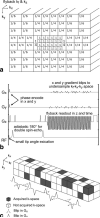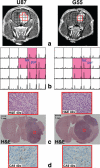Evaluation of heterogeneous metabolic profile in an orthotopic human glioblastoma xenograft model using compressed sensing hyperpolarized 3D 13C magnetic resonance spectroscopic imaging
- PMID: 22851374
- PMCID: PMC3630274
- DOI: 10.1002/mrm.24434
Evaluation of heterogeneous metabolic profile in an orthotopic human glioblastoma xenograft model using compressed sensing hyperpolarized 3D 13C magnetic resonance spectroscopic imaging
Abstract
High resolution compressed sensing hyperpolarized (13)C magnetic resonance spectroscopic imaging was applied in orthotopic human glioblastoma xenografts for quantitative assessment of spatial variations in (13)C metabolic profiles and comparison with histopathology. A new compressed sensing sampling design with a factor of 3.72 acceleration was implemented to enable a factor of 4 increase in spatial resolution. Compressed sensing 3D (13)C magnetic resonance spectroscopic imaging data were acquired from a phantom and 10 tumor-bearing rats following injection of hyperpolarized [1-(13)C]-pyruvate using a 3T scanner. The (13)C metabolic profiles were compared with hematoxylin and eosin staining and carbonic anhydrase 9 staining. The high-resolution compressed sensing (13)C magnetic resonance spectroscopic imaging data enabled the differentiation of distinct (13)C metabolite patterns within abnormal tissues with high specificity in similar scan times compared to the fully sampled method. The results from pathology confirmed the different characteristics of (13)C metabolic profiles between viable, non-necrotic, nonhypoxic tumor, and necrotic, hypoxic tissue.
Copyright © 2012 Wiley Periodicals, Inc.
Figures






